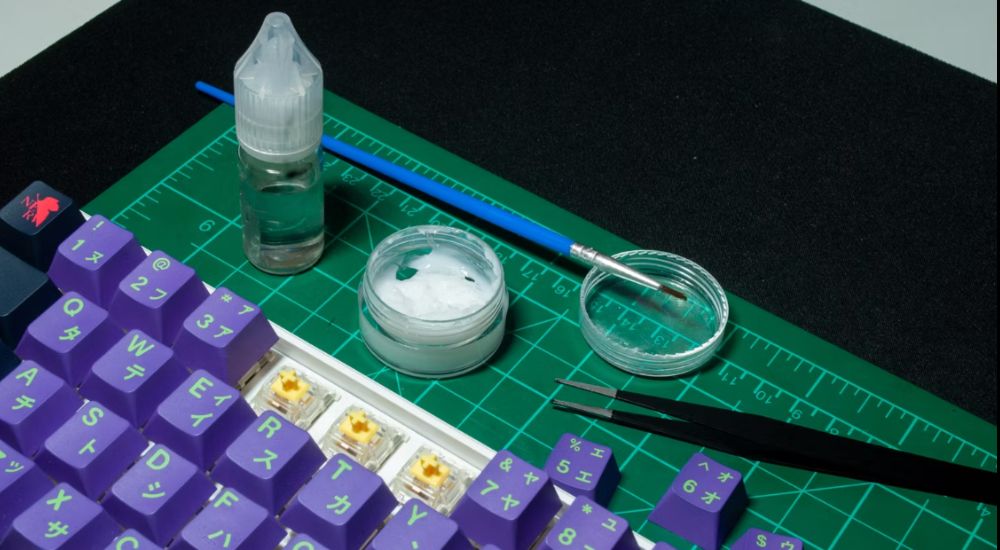Do you ever feel like your keyboard is not as smooth or responsive as it used to be? Maybe the keys are sticking or feeling a bit scratchy. Well, fear not! There's a solution that could potentially enhance your typing experience, making it as smooth as butter – by lubricating your keyboard switches. In this guide, we'll cover everything you need to know about lubricating your keyboard switches to keep them feeling smooth and responsive.
What Are Keyboard Switches?
First things first, let's talk about what keyboard switches are. Keyboard switches are the mechanisms beneath the keys on your keyboard that register each keystroke. There are different types of keyboard switches, including membrane switches and mechanical switches. Mechanical switches are further divided into various types like Cherry MX, Gateron, and more. These switches determine how your keyboard feels and sounds when you type.

Why Lubricate Keyboard Switches?
Over time, keyboard switches can become less smooth and responsive due to friction and wear. This can lead to keys feeling scratchy or sticky when you press them. Lubricating your keyboard switches can help reduce this friction, resulting in smoother keypresses and a more enjoyable typing experience. Additionally, lubrication can also help reduce noise from keypresses, making your keyboard quieter.

How to Lubricate Keyboard Switches
Lubricating the switches on your keyboard is a fairly simple process, yet it demands careful attention to detail. Here's a step-by-step guide:
1. Prepare Your Workspace:
Start by clearing off your desk and laying down a clean cloth or paper towel to catch any drips or spills. You'll also need a keycap puller, a small brush or cloth, and your chosen lubricant.
2. Remove the Keycaps:
Utilize a keycap puller to carefully detach the keycaps from your keyboard. Ensure not to apply excessive force to prevent damaging the switches.
3. Clean the Switches:
Utilize a small brush or cloth to eliminate any dust present on the exposed switches. This step is essential to ensure that the lubricant can penetrate the moving parts effectively.
4. Apply the Lubricant:
5. Replace the Keycaps:
6. Test Your Keyboard:
After lubricating your switches, test your keyboard to ensure that the keys feel smooth and responsive. If you notice any issues, you may need to reapply lubricant or adjust the keycaps.
Types of Lubricants for Keyboard Switches
Not every lubricant is appropriate for lubricating keyboard switches. Using the wrong type of lubricant can damage your keyboard or make the keys feel worse. Here are some commonly used lubricants for keyboard switches:
1. Silicone Grease:
This is one of the most commonly recommended lubricants for keyboard switches. It's a thick, silicone-based grease that provides excellent lubrication and helps reduce friction.
2. Krytox Lubricants:
Krytox is a brand of lubricants that is popular among keyboard enthusiasts. They come in different viscosities (thicknesses) and are known for their durability and effectiveness.
3. Dielectric Grease:
Some users prefer utilizing dielectric grease as an alternative method to lubricating keyboard switches. It's a silicone-based grease that's non-conductive, making it safe for use on electronic components.
Experience smoother switches with Keychron Klube Lubricant. Our Klube 105 switch lubricant ensures high-quality performance, offering a liquidy consistency for effortless application to switch springs and housing. Click here to buy now- Keychron Klube Lubricant

Tips for Lubricating Keyboard Switches
Here are some additional tips to keep in mind when lubricating your keyboard switches:
1. Start with a Clean Keyboard:
Make sure your keyboard is clean and free of dust and debris before you start lubricating the switches.
2. Use the Right Amount of Lubricant:
It's essential to use just the right amount of lubricant—not too much and not too little.
3. Take Your Time:
Don't rush the process. Take your time to ensure that each switch is properly lubricated.
4. Experiment:
Every keyboard is different, so don't be afraid to experiment with different lubricants and application techniques to find what works best for you.
Conclusion
Lubricating your keyboard switches can help keep them feeling smooth and responsive, prolonging the life of your keyboard and improving your typing experience. By following the steps outlined in this guide and using the right lubricant, you can keep your keyboard in top condition for years to come.
Elevate your typing experience with Keychron. Explore a variety of keyboard switches including Keychron Kailh Switch Set, Gateron Mechanical switches, and Cherry MX Switches. Craftsmanship and cutting-edge technology define our keyboards, ensuring a personalized and exceptional typing journey. Find the ideal switch for your style and enjoy a superior typing experience.

